Bioclimatic Condition Variability in the Central Region of Poland in the Period 2001–2024
Abstract
1. Introduction
2. Materials and Methods
2.1. Study Area
2.2. Climate Description
2.3. Data Sources
2.4. UTCI Calculation
2.5. Statistical Analysis
3. Results
3.1. Spatial Patterns
3.2. Statistical Significance
3.3. Temporal Trends
3.4. Extreme Events
4. Discussion and Summary
5. Conclusions
- The results of the research carried out on the Central Region of Poland (IV) show satisfactory applicability of the UTCI in analysis of spatial and temporal distribution of heat stress.
- Favorable bioclimatic conditions, characterized as “comfort,” comprised over 60% of the total occurrences, primarily during spring and autumn. On the other hand, unfavorable conditions related to extreme cold stress were rarely noted, underscoring the mild thermal stress in the region. The frequency of thermal stress fluctuated across seasons and years, with the most favorable conditions occurring from April to October. January and December were the least favorable months, while instances of “extreme heat stress” did not occur during the study period. Overall, the analysis highlights significant trends in thermal comfort and stress, showing the regional disparities and temporal changes in bioclimate conditions affecting human well-being.
- The average annual UTCI of 7.7 °C indicates “slight cold stress,” with variations among analyzed cities—higher values in the west and northwest compared to lower ones in the southeast. Maximum UTCI values showing “very strong heat stress” exceeded 40.0 °C mainly in July and August primarily in the western part, i.e., Zielona Góra and Wrocław, although for Warsaw (the largest city in Poland but located in the eastern part) the values also exceed 40.0 °C. It can be associated with the fact that during the summer, continental tropical air masses inflow over this part of Poland more frequently, bringing hot air and heat waves. Minimum values indicating “extreme cold stress” were recorded in the eastern region, occurring during the winter months.
- The study stated the trends in UTCI values and an overall increase across all analyzed stations in the region, with rates of increase varying from 0.6 °C to 1.8 °C per decade. Non-linear trends had higher coefficients of determination, suggesting that climate systems may exhibit non-linear responses in temporal stress distribution. Positive linear trends for heat stress categories were observed, especially in “strong heat stress” (category 2), contrasted by negative trends for “strong cold stress” (category −3), indicating a decrease in colder conditions. Therefore, it may be generalized that the temporal analysis of UTCI and related heat loads in the region shows a correlation with an increase in the air temperature, consistent with the climate change trend in the period 2001–2024.
- In the case of obtaining a linear trend, and such a situation occurring for the average UTCI values and the frequencies of individual thermal stress categories, such equations can be extrapolated, with some restrictions. It gives the opportunity of forecasting the occurrence of individual thresholds of the Index and thermal stress categories in the future.
- The results of this analysis can be used in spatial planning, adaptation, and mitigation of the effects of climate change, particularly in relation to the increasing frequency of extreme thermal stress, as well as to prepare transparent information on the bioclimate for both city tourism and agritourism.
- These findings underscore the need for further research and analysis of bioclimatic conditions in Poland, as well as other regions, on a new classification. The current classification comes from a period when the commonly used biometeorological indices, e.g., UTCI and others, have not been developed. It is therefore valid to attempt to update or specify the bioclimatic subdivision of Poland, taking into account the spatial and temporal distribution of present-day available parameters.
Author Contributions
Funding
Institutional Review Board Statement
Informed Consent Statement
Data Availability Statement
Conflicts of Interest
References
- IPCC. Climate Change 2023: Synthesis Report. In Contribution of Working Groups I, II, and III to the 6th Assessment Report of the IPCC; Lee, H., Romeo, J., Eds.; IPCC: Geneva, Switzerland, 2023; pp. 35–115. [Google Scholar] [CrossRef]
- Kambezidis, H.D.; Psiloglou, B.E.; Varotsos, K.V.; Giannakopoulos, C. Climate Change and Thermal Comfort in Greece. Climate 2021, 9, 10. [Google Scholar] [CrossRef]
- NOAA. Climate at a Glance: Global Time Series 2018. Available online: https://www.ncdc.noaa.gov/cag/ (accessed on 1 February 2025).
- Krüger, E.L. (Ed.) Literature Review on UTCI Applications. In Applications of the Universal Thermal Climate Index UTCI in Biometeorology; Springer: Berlin/Heidelberg, Germany, 2021; Volume 4, pp. 23–65. [Google Scholar] [CrossRef]
- Antonini, E.; Vodola, V.; Gaspari, J.; De Giglio, M. Outdoor Wellbeing and Quality of Life: A Scientific Literature Review on Thermal Comfort. Energies 2020, 13, 2079. [Google Scholar] [CrossRef]
- Naskar, P.R.; Mohapatra, M.; Singh, G.P.; Das, U. Spatiotemporal variations of UTCI based discomfort over India. J. Earth Syst. Sci. 2024, 133, 47. [Google Scholar] [CrossRef]
- Pantavou, K.; Kotroni, V.; Kyros, G.; Lagouvardos, K. Thermal bioclimate in Greece based on the Universal Thermal Climate Index (UTCI) and insights into 2021 and 2023 heatwaves. Theor. Appl. Climatol. 2024, 155, 6661–6675. [Google Scholar] [CrossRef]
- Vukmirovic, M.; Gavrilovic, S.; Stojanovic, D. The Improvement of the Comfort of Public Spaces as a Local Initiative in Coping with Climate Change. Sustainability 2019, 11, 6546. [Google Scholar] [CrossRef]
- Pecelj, M.; Matzarakis, A.; Vujadinovic, M.; Radovanovic, M.; Vagic, N.; Ðuric, D.; Cvetkovic, M. Temporal Analysis of Urban-Suburban PET, mPET and UTCI Indices in Belgrade (Serbia). Atmosphere 2021, 12, 916. [Google Scholar] [CrossRef]
- Brecht, B.M.; Schädler, G.; Schipper, J.W. UTCI climatology and its future change in Germany—An RCM ensemble approach. Meteorol. Z. 2020, 29, 97–116. [Google Scholar] [CrossRef]
- Błażejczyk, K.; Lindner-Cendrowska, K.; Kuchcik, M.; Baranowski, J.; Szmyd, J.; Mileski, P. Biothermal conditions of some housing estates in Warsaw. In Proceedings of the ICUC8—8th International Conference on Urban Climates, UCD, Dublin, Ireland, 6–10 August 2012. [Google Scholar]
- Araźny, A.; Uscka—Kowalkowska, J.; Kejna, M.; Przybylak, R.; Kunz, M. Diversity of biometeorological conditions in Toruń and its suburban area in 2012. Pol. Geogr. Rev. 2016, 88, 1, 87–108. (In Polish) [Google Scholar] [CrossRef]
- Mąkosza, A.; Nidzgorska-Lencewicz, J. Selected thermal and biothermal aspects of cities in Poland. Pol. J. Natur. Sc. 2017, 32, 771–782. [Google Scholar]
- Błażejczyk, K.; Baranowski, J.; Błażejczyk, A. Wpływ klimatu na stan zdrowia w Polsce: Stan aktualny oraz prognoza do 2100 roku. 2015 Warsaw IGiPZ PAN; Wyd. Akademickie Sedno: Warsaw, Poland, 2015. [Google Scholar]
- Lindner-Cendrowska, K.; Bröde, P. The evaluation of biothermal conditions for various forms of climatic therapy based on UTCI adjusted for activity. Geogr. Pol. 2021, 94, 167–182. [Google Scholar] [CrossRef]
- Jalali, R.; Romaszko, J.; Dragańska, E.; Gromadziński, L.; Cymes, I.; Sokołowski, J.B.; Poterała, M.; Markuszewski, L.; Romaszko-Wojtowicz, A.M.; Jeznach-Steinhagen, A.; et al. Heat and cold stress increases the risk of paroxysmal supraventricular tachycardia. PLoS ONE 2024, 19, e0296412. [Google Scholar] [CrossRef]
- Krzyżewska, A.; Wereski, S.; Dobek, M. Summer UTCI variability in Poland in the twenty-first century. Int. J. Biometeorol. 2021, 65, 1497–1513. [Google Scholar] [CrossRef] [PubMed]
- Miszczuk, B.; Furdak, A. Changes in biothermal conditions in the Sudetes Mountains and their foreland in relation to the circulation conditions. Misc. Geogr. Reg. Stud. Dev. 2024, 28, 29–38. [Google Scholar] [CrossRef]
- Tomczyk, A.M.; Matzarakis, A. Characteristic of bioclimatic conditions in Poland based on Physiologically Equivalent Temperature. Int. J. Biometeorol. 2023, 67, 1991–2009. [Google Scholar] [CrossRef]
- Tomczyk, A.M.; Bednorz, E. Regional and seasonal variability in human thermal stress in Poland. Theor. Appl. Climatol. 2023, 152, 787–800. [Google Scholar] [CrossRef]
- Rozbicka, K.; Rozbicki, T. Long-term variability of bioclimatic conditions and tourism potential for Warsaw agglomeration (Poland). Int. J. Biometeorol. 2021, 65, 1485–1495. [Google Scholar] [CrossRef] [PubMed]
- Rozbicka, K.; Rozbicki, T. Summer weather perception and preferences in Powsin Culture Park (Warsaw, Poland). Int. J. Biometeorol. 2023, 67, 793–805. [Google Scholar] [CrossRef]
- Głogowski, A.; Perona, P.; Bryś, T.; Bryś, K. Changes of Bioclimatic Conditions in the Kłodzko Region (SW Poland). Sustainability 2022, 14, 6770. [Google Scholar] [CrossRef]
- Oudin, Å.D.; Schifano, P.; Asta, F.; Lallo, A.; Michelozzi, P.; Rocklöv, J.; Forsberg, B. The Effect of Heat Waves on Mortality in Susceptible Groups: A Cohort Study of a Mediterranean and a Northern European City. Environ. Health 2015, 14, 30. [Google Scholar] [CrossRef]
- Pogačar, T.; Žnidaršič, Z.; Kajfež Bogataj, L.; Flouris, A.D.; Poulianiti, K.; Črepinšek, Z. Heat Waves Occurrence and Outdoor Workers’ Self-Assessment of Heat Stress in Slovenia and Greece. Int. J. Environ. Res. Public Health 2019, 16, 597. [Google Scholar] [CrossRef]
- Crepinšek, Z.; Žnidaršic, Z.; Pogacar, T. Spatio-Temporal Analysis of the Universal Thermal Climate Index (UTCI) for the Summertime in the Period 2000–2021 in Slovenia: The Implication of Heat Stress for Agricultural Workers. Agronomy 2023, 13, 331. [Google Scholar] [CrossRef]
- Szer, I.; Szer, J. The influence of external environment on workers on scaffolding illustrated by UTCI. Open Eng. 2021, 11, 929–936. [Google Scholar] [CrossRef]
- Chodor, W.; Chmura, P.; Chmura, J.; Andrzejewski, M.; Jówko, E.; Buraczewski, T.; Drozdwowski, A.; Rokita, A.; Konefał, M. Impact of climatic conditions projected at the World Cup in Qatar 2022 on repeated maximal efforts in soccer players. Peer J. 2021, 9, e12658. [Google Scholar] [CrossRef]
- Matzarakis, A.; Graw, K. Human Bioclimate Analysis for the Paris Olympic Games. Atmosphere 2022, 13, 269. [Google Scholar] [CrossRef]
- Kozłowska-Szczęsna, T.; Błażejczyk, K.; Krawczyk, B.; Limanówka, D. Bioklimat Uzdrowisk Polskich i Możliwości Jego Wykorzystania w Lecznictwie; PANL IgiPZ: Warszawa, Poland, 2002. [Google Scholar]
- Kozłowska-Szczęsna, T.; Krawczyk, K.; Błażejczyk, B. Human Bioclimatology. Methods and Applications Monographies; Polish Academy of Sciences, Institute of Geaography and Spatial Organization: Warsaw, Poland, 1997; Volume 1, p. 200. (In Polish) [Google Scholar]
- Arnfield, A.J. Köppen Climate Classification|Definition, System, Map. Encyclopaedia Britannica. 2020. Available online: https://www.britannica.com/science/Koppen-climate-classification (accessed on 1 June 2025).
- Institute of Meteorology and Water Management—National Research Institute. Available online: https://klimat.imgw.pl/pl/biuletyn-monitoring/ (accessed on 25 April 2025).
- World Meteorological Organization (WMO). Guide to Instruments and Methods of Observation (WMO-No. 8); World Meteorological Organization: Geneva, Switzerland, 2021–2023. [Google Scholar]
- Rozbicki, T.; Kleniewska, M.; Rozbicka, K.; Majewski, G.; Gołaszewski, D. Relating urban development and densification to temporary changes in the air temperature in Warsaw (Poland). Theor. Appl. Climatol. 2020, 142, 513–523. [Google Scholar] [CrossRef]
- Institute of Meteorology and Water Management—National Research Institute. Public Data. Available online: https://danepubliczne.imgw.pl (accessed on 10 January 2025).
- Błażejczyk, K.; Epstein, Y.; Jendritzky, G.; Staiger, H.; Tinz, B. Comparison of UTCI to selected thermal indices. Int. J. Biometeorol. 2012, 56, 515–535. [Google Scholar] [CrossRef]
- Bröde, P.; Fiala, D.; Błazejczyk, K.; Holmér, I.; Jendritzki, G.; Kampmann, B.; Tinz, B.; Havenith, G. Deriving the operational procedure for the Universal Thermal Climate Index (UTCI). Int. J. Biometeorol. 2012, 56, 481–494. [Google Scholar] [CrossRef] [PubMed]
- Fiala, D.; Lomas, K.J.; Stohrer, M. A computer model of human thermoregulation for a wide range of environmental conditions: The passive system. J. Appl. Physiol. 1999, 87, 1957–1972. [Google Scholar] [CrossRef]
- Fiala, D.; Lomas, K.J.; Stohrer, M. Computer prediction of human thermoregulatory and temperature responses to a wide range of environmental conditions. Int. J. Biometeorol. 2001, 45, 143–159. [Google Scholar] [CrossRef]
- Polish Academy of Sciences, Department of Geoecology and Climatology. BioKlima (n.d.) ver.2.6. Available online: https://www.igipz.pan.pl/climate-research-department.html (accessed on 15 January 2025).
- Błażejczyk, K.; Jendritzky, G.; Brode, P.; Fiala, D.; Havenith, G.; Epstein, Y.; Psikuta, A.; Kampmann, B. An Introduction to the Universal Thermal Climate Indeks (UTCI). Geogr. Pol. 2013, 86, 5–10. [Google Scholar] [CrossRef]
- Błażejczyk, K.; Idzikowska, D.; Błażejczyk, A. Forecast changes for heat and cold stress in Warsaw in the 21st century, and their possible influence on mortality risk. Pap. Glob. Chang. 2013, 20, 47–62. [Google Scholar] [CrossRef]
- Lindner, K. Ocena klimatu odczuwalnego w Warszawie na podstawie wskaźnika UTCI. (Assessment of sensible climate in Warsaw using UTCI). Pr. Stud. Geogr. 2011, 47, 285–291. [Google Scholar]
- Kuchcik, M. Thermal conditions in Poland at the turn of the 20th and 21st centuries, and their impact on mortality. Geogr. Stud. 2017, 263, 1–10. (In Polish) [Google Scholar]
- Mąkosza, A. Bioclimatic conditions of the Lubuskie Voivodeship. Geogr. Pol. 2013, 86, 37–46. [Google Scholar] [CrossRef]
- Mąkosza, A. Bioclimatic conditions and thermal seasons of the year in Szczecin. Geogr. Pol. 2021, 94, 283–299. [Google Scholar] [CrossRef]
- Błażejczyk, K. UTCI—10 years of applications. Int. J. Biometeorol. 2021, 65, 1461–1462. [Google Scholar] [CrossRef]
- Rozbicka, K.; Rozbicki, T. Variability of UTCI index in South Warsaw depending on atmospheric circulation. Theor. Appl. Climatol. 2018, 133, 511–520. [Google Scholar] [CrossRef]
- Okoniewska, M. Specificity of Meteorological and Biometeorological Conditions in Central Europe in Centre of Urban Areas in June 2019 (Bydgoszcz, Poland). Atmosphere 2021, 12, 1002. [Google Scholar] [CrossRef]
- Tomczyk, A.M. Bioclimatic Conditions of June 2019 in Poland on a Multi-Year Background (1966–2019). Atmosphere 2021, 12, 1117. [Google Scholar] [CrossRef]
- Półrolniczak, M.; Szyga-Pluta, K.; Kolendowicz, L. Bioklimat wybranych miast pasa Pobrzeży Południowobałtyckich na podstawie uniwersalnego wskaźnika obciążenia cieplnego. Acta Geogr. Lodz. 2016, 104, 147–161. [Google Scholar]
- Koźmiński, C.Z.; Michalska, B. Ocena bioklimatycznych warunków rekreacji i turystyki w strefie polskiego Wybrzeża Bałtyku na podstawie wskaźnika UTCI (Assessment of bioclimatic conditions for recreation and tourism in the Polish Baltic coastal zone using the UTCI index). Pol. Geogr. Rev. 2019, 91, 113–126. [Google Scholar]
- Nowosad, M.; Rodzik, B.; Wereski, S.; Dobek, M. The UTCI index in Lesko and Lublin and its circulation determinants. Geogr. Pol. 2013, 86, 29–36. [Google Scholar] [CrossRef]
- Dobek, M.; Demczuk, P.; Nowosad, M. Spatial variation of the Universal Thermal Climate Index in Lublin in specified weather scenarios. Ann. UMCS Sec. B. 2013, 68, 21–38. [Google Scholar]
- Kozłowska-Szczęsna, T. Anthropoclimate of Poland: An Attempt of a Synthesis; Zeszyty Instytutu Geografii i Przestrzennego Zagospodarowania PAN: Warsaw, Poland, 1991. [Google Scholar]
- Błażejczyk, K. Biotermiczne cechy klimatu Polski. Przegląd Geogr. 2003, 75, 525–543. [Google Scholar]
- Kozłowska-Szczęsna, T.; Krawczyk, B.; Błażejczyk, K. The main features of bioclimatic conditions at Polish health resorts. Geogr. Pol. 2004, 77, 45–61. [Google Scholar]
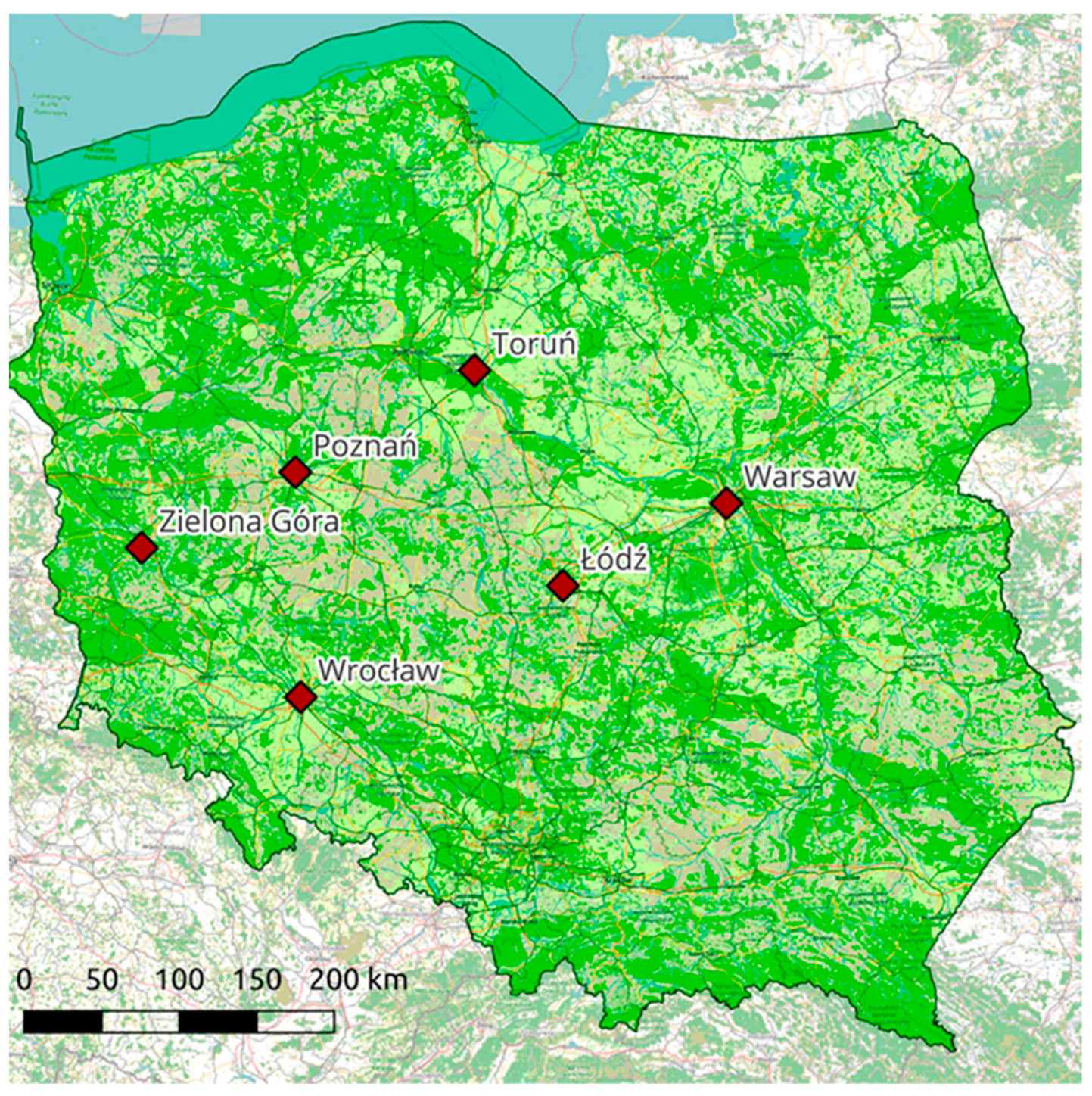

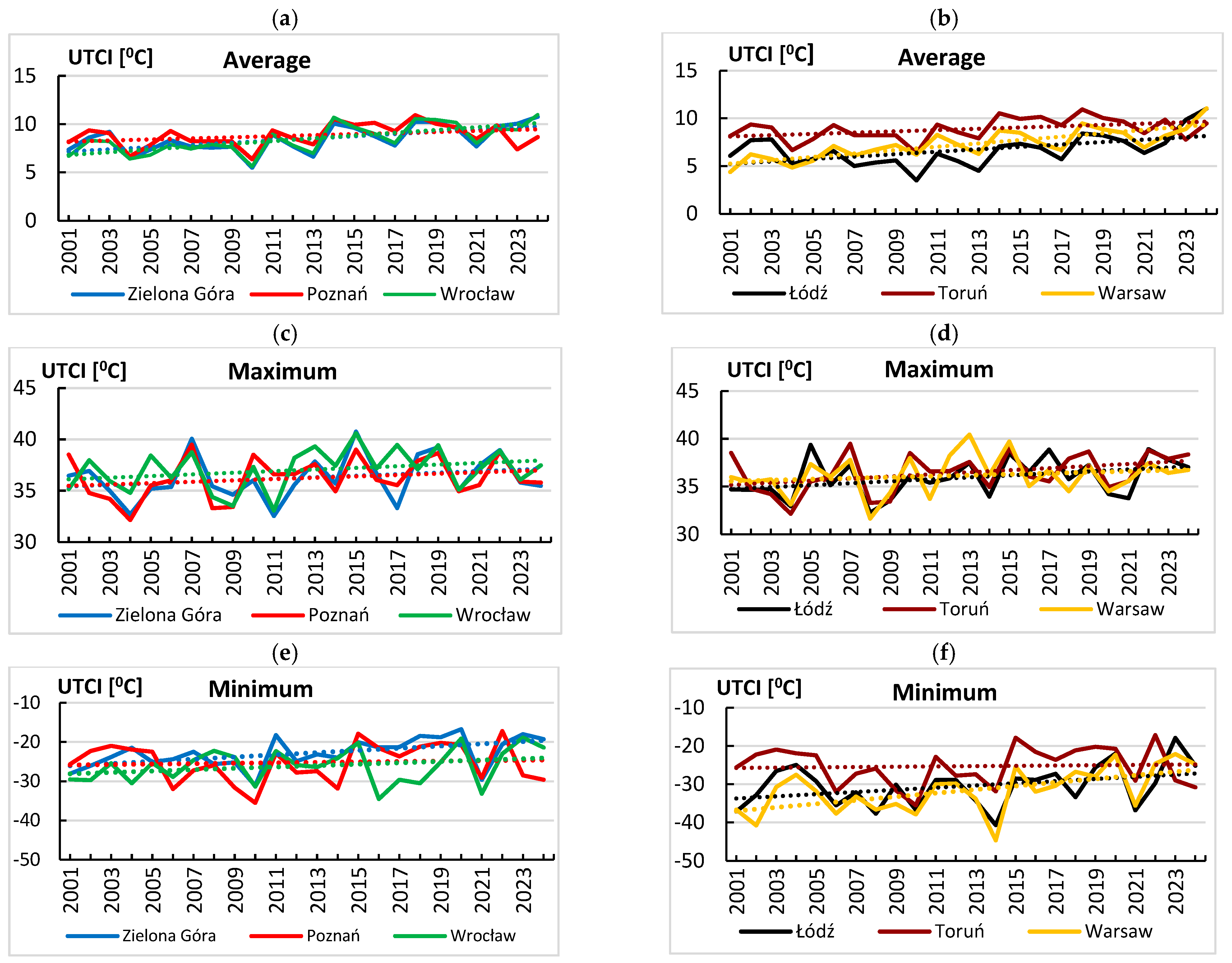
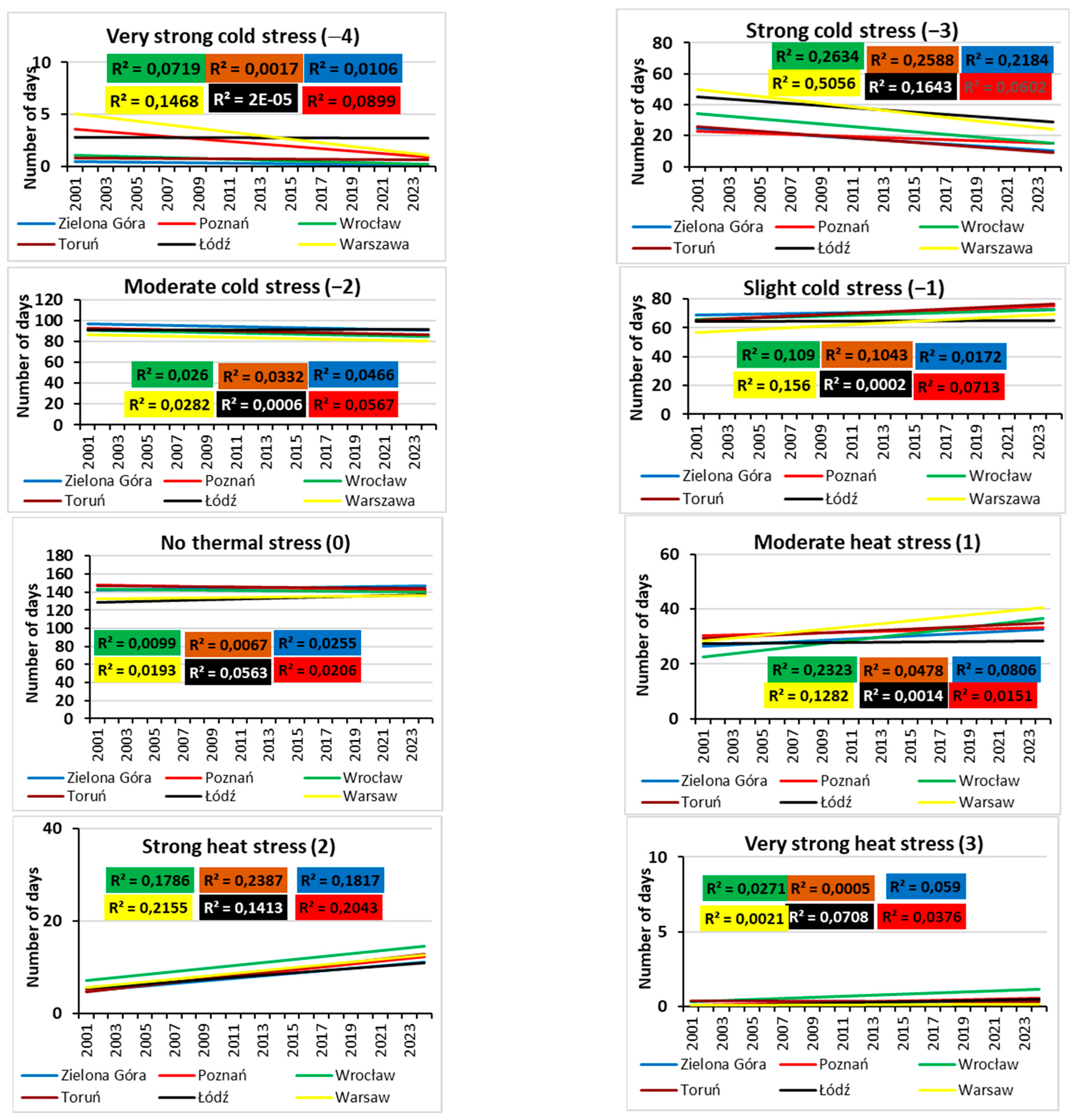
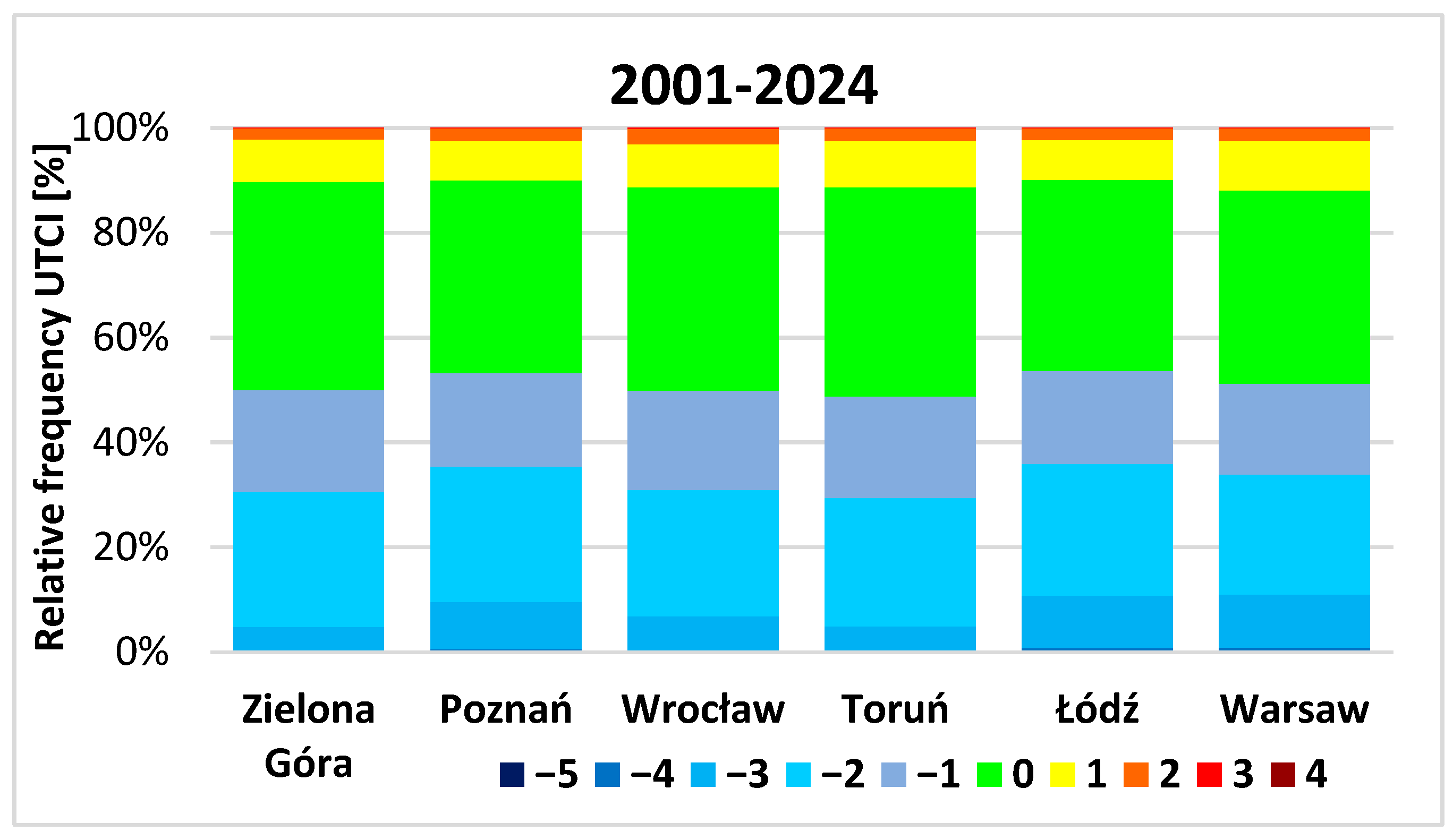
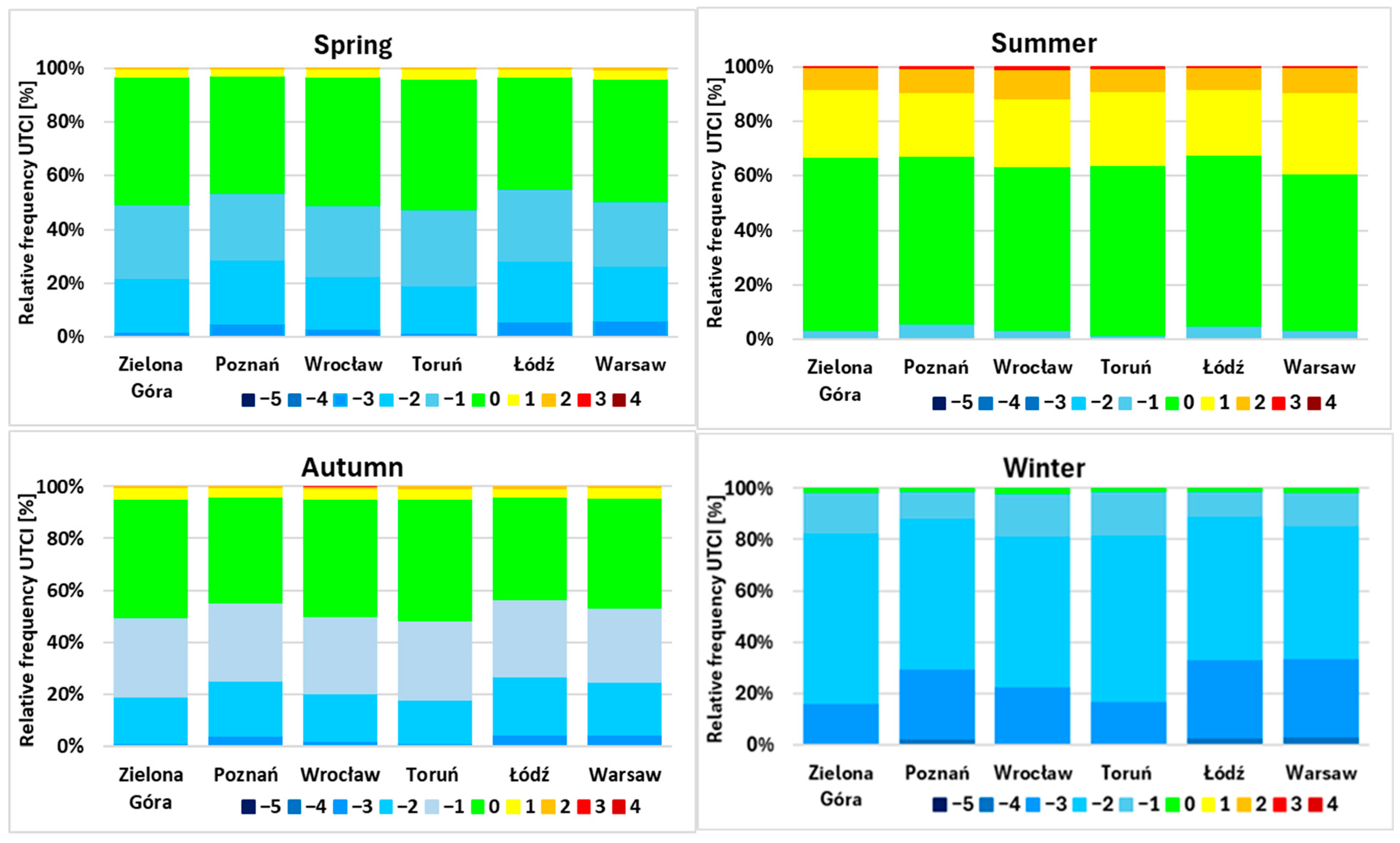

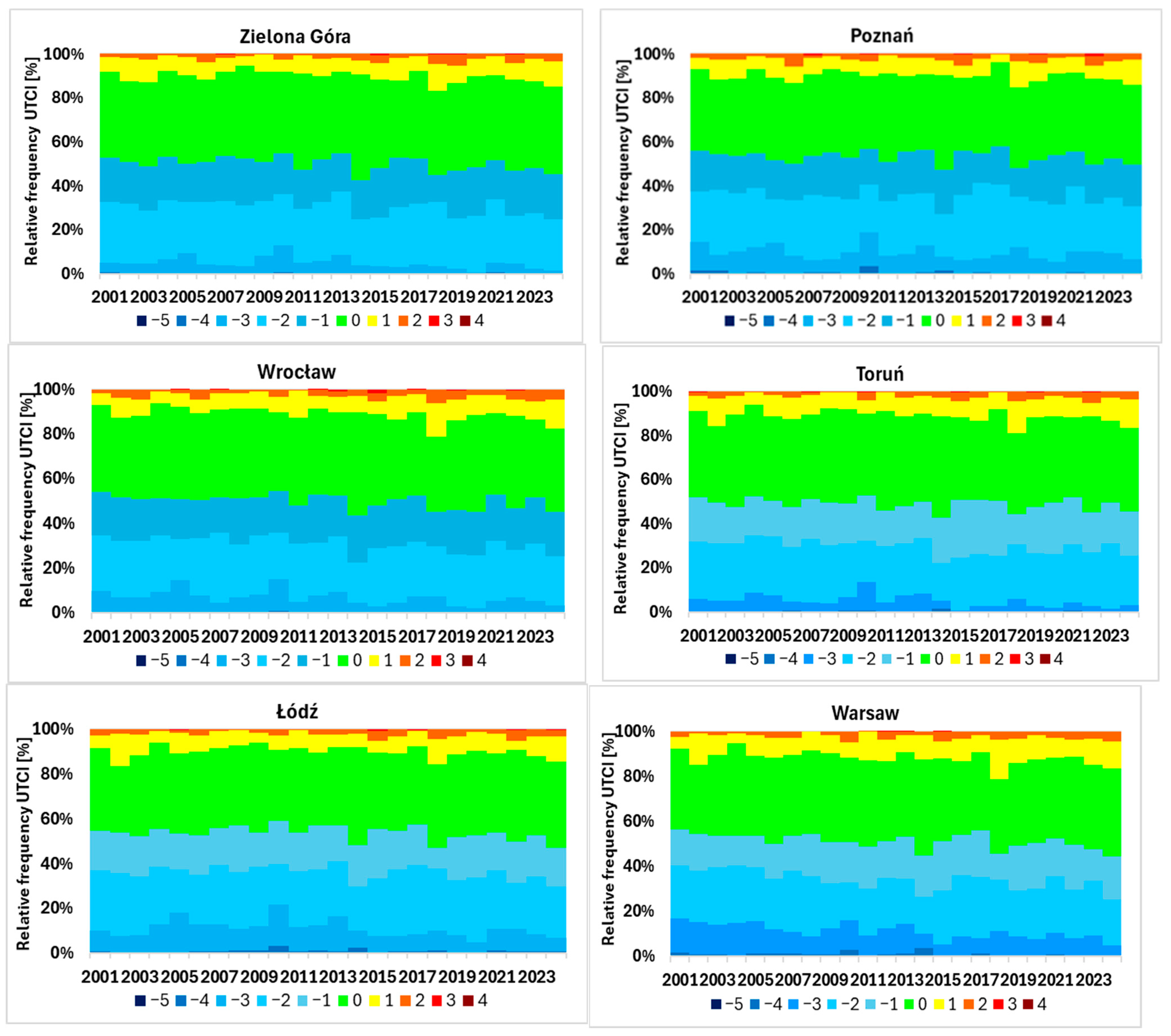
| UTCI (°C) Range | Number Category | Stress Category |
|---|---|---|
| above 46.0 | 4 | extreme heat stress |
| 38.1–46.0 | 3 | very strong heat stress |
| 32.1–38.0 | 2 | strong heat stress |
| 26.1–32.0 | 1 | moderate heat stress |
| 9.1–26.0 | 0 | no thermal stress |
| 0.1–9.0 | −1 | slight cold stress |
| −12.9–0.0 | −2 | moderate cold stress |
| −26.9–13.0 | −3 | strong cold stress |
| −39.9–27.0 | −4 | very strong cold stress |
| below −40.0 | −5 | extreme cold stress |
| Stations | Annual Average Values of UTCI [°C] |
|---|---|
| Zielona Góra | 8.4 |
| Poznań | 6.7 |
| Wrocław | 8.4 |
| Toruń | 9.0 |
| Łódź | 6.5 |
| Warsaw | 7.2 |
| 2001–2024 | 7.7 |
| Stations | Trend equations | R2 | |
|---|---|---|---|
| Average | Poznań | y = 0.0554x + 8.1402 | 0.11 |
| Zielona Góra | y = 0.1133x + 7.0603 | 0.33 | |
| Wrocław | y = 0.1433x + 6.6727 | 0.47 | |
| Toruń | y = 0.067x + 8.0445 | 0.17 | |
| Warsaw | y = 0.1772x + 5.0734 | 0.64 | |
| Łódź | y = 0.1264x + 5.117 | 0.28 | |
| Maximum | Poznań | y = 0.0658x + 35.417 | 0.05 |
| Zielona Góra | y = 0.0748x + 35.341 | 0.06 | |
| Wrocław | y = 0.0796x + 36.038 | 0.08 | |
| Toruń | y = 0.1099x + 35.057 | 0.14 | |
| Warsaw | y = 0.0515x + 35.515 | 0.03 | |
| Łódź | y = 0.1028x + 34.627 | 0.13 | |
| Minimum | Poznań | y = 0.0551x − 25.909 | 0.01 |
| Zielona Góra | y = 0.2788x − 26.318 | 0.27 | |
| Wrocław | y = 0.1749x − 28.261 | 0.08 | |
| Toruń | y = 0.0381x − 25.77 | 0.00 | |
| Warsaw | y = 0.4659x − 37.43 | 0.32 | |
| Łódź | y = 0.284x − 34.021 | 0.14 |
Disclaimer/Publisher’s Note: The statements, opinions and data contained in all publications are solely those of the individual author(s) and contributor(s) and not of MDPI and/or the editor(s). MDPI and/or the editor(s) disclaim responsibility for any injury to people or property resulting from any ideas, methods, instructions or products referred to in the content. |
© 2025 by the authors. Licensee MDPI, Basel, Switzerland. This article is an open access article distributed under the terms and conditions of the Creative Commons Attribution (CC BY) license (https://creativecommons.org/licenses/by/4.0/).
Share and Cite
Rozbicka, K.; Rozbicki, T.; Majewski, G. Bioclimatic Condition Variability in the Central Region of Poland in the Period 2001–2024. Atmosphere 2025, 16, 774. https://doi.org/10.3390/atmos16070774
Rozbicka K, Rozbicki T, Majewski G. Bioclimatic Condition Variability in the Central Region of Poland in the Period 2001–2024. Atmosphere. 2025; 16(7):774. https://doi.org/10.3390/atmos16070774
Chicago/Turabian StyleRozbicka, Katarzyna, Tomasz Rozbicki, and Grzegorz Majewski. 2025. "Bioclimatic Condition Variability in the Central Region of Poland in the Period 2001–2024" Atmosphere 16, no. 7: 774. https://doi.org/10.3390/atmos16070774
APA StyleRozbicka, K., Rozbicki, T., & Majewski, G. (2025). Bioclimatic Condition Variability in the Central Region of Poland in the Period 2001–2024. Atmosphere, 16(7), 774. https://doi.org/10.3390/atmos16070774






